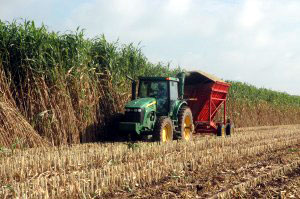COLLEGE STATION – Dr. Bill McCutchen sees the potential for the southeast to become the ‘Saudi Arabia’ for production of dedicated energy crops.
“It’s the Bioenergy Belt,” said McCutchen, executive associate director of Texas A&M AgriLife Research, at the Growing Texas Conference held in College Station recently. Attendees heard from numerous experts discussing future water and energy needs in Texas.
McCutchen provided attendees an overview of research done by the agency in developing potential dedicated energy crops for biofuels. Whether it’s energy sorghum or algae, McCutchen said too much emphasis has been placed on corn, as its needs are for both food and livestock feed production.

“Corn is not the way to grow our biofuels industry,” McCutchen said. “What we are going to see is an emergence of cellulosic-based conversion facilities, and when this infrastructure is in place, we will see a new set of dedicated energy crops that will complement food and fiber crops. We are starting to see the deployment of cellulosic and biomass conversion facilities for biofuels being put into place.”
McCutchen said the Texas Gulf Coast to the eastern border is the “sweet spot” for biofuel production and growing dedicated energy crops that are also drought tolerant.
“We should have ample rainfall to grow these new crops on a consistent basis in these areas,” McCutchen said, pointing to a slide depicting a map of Texas and its eastern portion.
“We are now working with BP, Chevron, Ceres and others to make this a reality for Texas and the Southeast.”
McCutchen said the agency’s corporate research partnership strategy was developed five years ago and has grown to $50 million dedicated to research and development.
“Overall, our bioenergy research goal is for these energy crops not to compete with food and feed,” he said. “Corn is not the way to grow our biofuels industry.”
The bioenergy research program is partially driven by the federal renewable fuel standard. Adam Helms, AgriLife Research assistant director for corporate relations bioenergy programs, said the thrust of the program is designing purpose-built germplasm for specific biofuel conversion processes. Energy sorghums, energy canes and high biomass pennisetum grasses represent the bulk of AgriLife’s bioenergy grass development program.
“We are using plant breeding coupled with next-generation sequencing to expedite germplasm development,” he said. “This is also known as marker-assisted breeding, which allows our plant breeders to quickly identify and advance traits of interest.”
Helms said if you have a trait controlled by 20 genes, the chance of moving all of those genes into an offspring is greater than one in a billion. There are about 2 billion corn seeds planted in the U.S. annually, so this would be equivalent to finding two plants.
“With the application of marker assisted-breeding, that gets dropped down to one in 20,” he said. “This technology allows breeders to bring new products to the market for producers faster.”